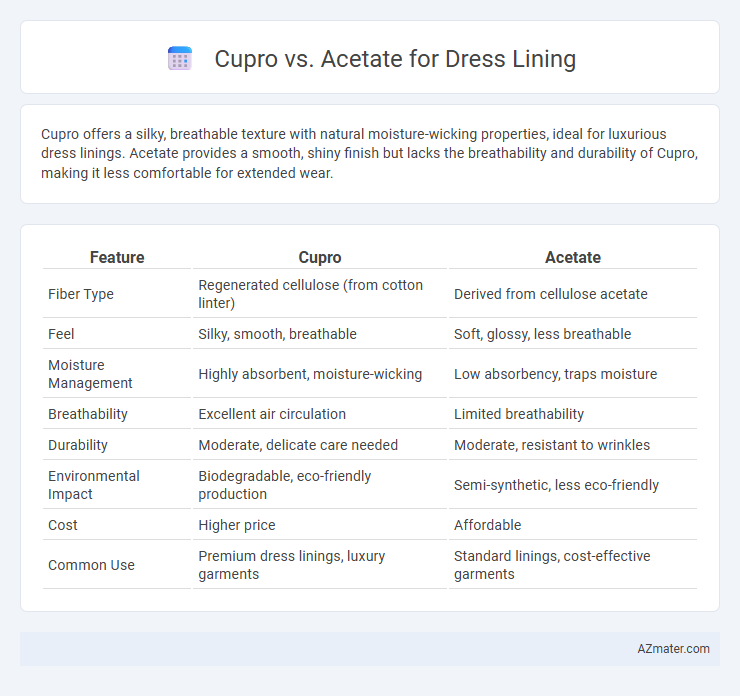Cupro offers a silky, breathable texture with natural moisture-wicking properties, ideal for luxurious dress linings. Acetate provides a smooth, shiny finish but lacks the breathability and durability of Cupro, making it less comfortable for extended wear.
Table of Comparison
| Feature | Cupro | Acetate |
|---|---|---|
| Fiber Type | Regenerated cellulose (from cotton linter) | Derived from cellulose acetate |
| Feel | Silky, smooth, breathable | Soft, glossy, less breathable |
| Moisture Management | Highly absorbent, moisture-wicking | Low absorbency, traps moisture |
| Breathability | Excellent air circulation | Limited breathability |
| Durability | Moderate, delicate care needed | Moderate, resistant to wrinkles |
| Environmental Impact | Biodegradable, eco-friendly production | Semi-synthetic, less eco-friendly |
| Cost | Higher price | Affordable |
| Common Use | Premium dress linings, luxury garments | Standard linings, cost-effective garments |
Introduction: Understanding Cupro and Acetate Dress Linings
Cupro, a regenerated cellulose fiber derived from cotton linter, offers a silky, breathable, and hypoallergenic dress lining ideal for high-end garments. Acetate, made from cellulose acetate fibers, provides a glossy finish and smooth texture but tends to be less breathable and more prone to static compared to cupro. Both materials enhance dress lining comfort and aesthetics, with cupro favored for moisture-wicking properties and acetate chosen for its vibrant sheen and affordability.
Fabric Origins: What Are Cupro and Acetate?
Cupro is a regenerated cellulose fiber derived from cotton linter, a byproduct of cotton production, known for its silky texture and breathability that enhances comfort in dress linings. Acetate, made from cellulose acetate fibers sourced from wood pulp or cotton linters, offers a smooth, glossy finish and excellent drape, often used to create luxurious linings with vibrant colors. Both fabrics provide moisture-wicking properties but differ in environmental impact and durability, with cupro being more eco-friendly and acetate requiring careful care to prevent damage.
Texture and Feel: Comparing Cupro vs Acetate
Cupro exhibits a smooth, silk-like texture with a soft, breathable feel that enhances comfort in dress linings, while acetate offers a glossy finish with a slightly slicker hand but less breathability. The natural origin of cupro, derived from cotton linter, contributes to its exceptional moisture-wicking properties, making it preferable for all-day wear. Acetate, made from cellulose acetate fibers, tends to feel cooler and less natural against the skin, often resulting in a less comfortable experience in warm conditions.
Breathability and Comfort: Which Lining Wins?
Cupro excels in breathability due to its natural cellulose fiber origin, allowing better moisture absorption and airflow, which enhances comfort during prolonged wear. Acetate, while smooth and silky, tends to trap heat and moisture, making it less breathable but effective for a luxurious feel and drape. For dress linings prioritizing ventilation and comfort, Cupro consistently outperforms Acetate in keeping the wearer cool and dry.
Moisture Management: Absorbency and Drying Time
Cupro excels in moisture management due to its high absorbency, drawing moisture away from the skin quickly and promoting breathability in dress linings. It absorbs nearly twice as much moisture as acetate, ensuring comfort during prolonged wear. While acetate dries faster initially, Cupro's ability to retain and release moisture gradually provides a more balanced and effective moisture regulation for dress linings.
Sustainability and Environmental Impact
Cupro, a regenerated cellulose fiber made from cotton linter, offers superior sustainability with its biodegradable properties and low environmental footprint compared to acetate. Acetate, derived from wood pulp and treated with chemical solvents, poses challenges in biodegradability and generates more environmental pollutants during production. Choosing cupro for dress linings supports eco-friendly fashion by minimizing waste and reliance on non-renewable resources.
Durability and Everyday Wear
Cupro fabric offers superior durability and breathability compared to acetate, making it ideal for dress linings intended for everyday wear. Its natural fiber composition allows for better moisture absorption and resistance to wear and tear, extending the garment's lifespan. Acetate, while smooth and shiny, tends to be less resilient and more prone to damage under frequent use, reducing its suitability for long-term durability.
Care Instructions: Washing and Maintenance
Cupro dress lining requires gentle care with hand washing in cold water or dry cleaning to maintain its silky texture and prevent shrinkage. Acetate linings are best preserved by dry cleaning only, as washing in water can cause fabric damage and loss of sheen. Proper storage in a cool, dry place helps extend the longevity of both cupro and acetate dress linings.
Cost Comparison: Price Points and Value
Cupro, a regenerated cellulose fiber derived from cotton linter, typically costs more than acetate due to its superior breathability and luxurious silk-like feel, making it a premium choice for dress lining. Acetate, produced from cellulose acetate fibers, is generally less expensive and offers a smooth, shiny appearance but lacks the moisture-wicking properties and durability found in cupro linings. While acetate provides cost-effective value for budget-conscious consumers, cupro justifies its higher price point through enhanced comfort, longevity, and environmental sustainability.
Choosing the Best Lining: Cupro vs Acetate for Your Dress
Cupro lining offers breathability, moisture-wicking properties, and a silky texture that enhances comfort and durability in dress construction, making it ideal for high-quality, breathable garments. Acetate lining provides a smooth, lustrous finish with excellent drape and affordability, but it may lack the breathability and longevity of cupro. When choosing the best lining for your dress, consider cupro for luxury and comfort or acetate for cost-effective, elegant appearance.

Infographic: Cupro vs Acetate for Dress Lining
 azmater.com
azmater.com